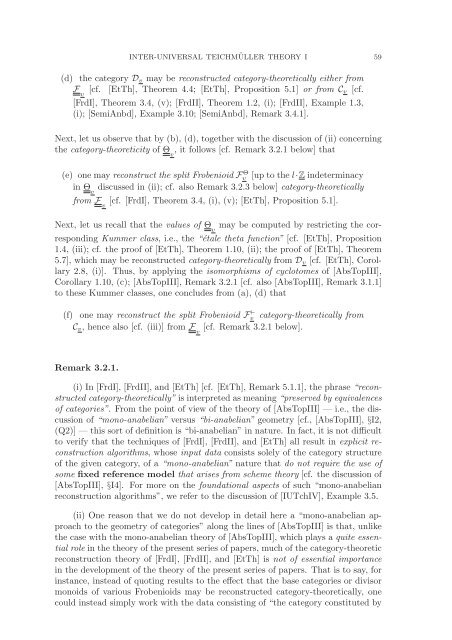Inter-universal Teichmuller Theory I: Construction of Hodge Theaters
Inter-universal Teichmuller Theory I: Construction of Hodge Theaters
Inter-universal Teichmuller Theory I: Construction of Hodge Theaters
You also want an ePaper? Increase the reach of your titles
YUMPU automatically turns print PDFs into web optimized ePapers that Google loves.
INTER-UNIVERSAL TEICHMÜLLER THEORY I 59<br />
(d) the category D v may be reconstructed category-theoretically either from<br />
F v<br />
[cf. [EtTh], Theorem 4.4; [EtTh], Proposition 5.1] or from C v [cf.<br />
[FrdI], Theorem 3.4, (v); [FrdII], Theorem 1.2, (i); [FrdII], Example 1.3,<br />
(i); [SemiAnbd], Example 3.10; [SemiAnbd], Remark 3.4.1].<br />
Next, let us observe that by (b), (d), together with the discussion <strong>of</strong> (ii) concerning<br />
the category-theoreticity <strong>of</strong> Θ v<br />
, it follows [cf. Remark 3.2.1 below] that<br />
(e) one may reconstruct the split Frobenioid Fv<br />
Θ [up to the l·Z indeterminacy<br />
in Θ v<br />
discussed in (ii); cf. also Remark 3.2.3 below] category-theoretically<br />
from F v<br />
[cf. [FrdI], Theorem 3.4, (i), (v); [EtTh], Proposition 5.1].<br />
Next, let us recall that the values <strong>of</strong> Θ v<br />
may be computed by restricting the corresponding<br />
Kummer class, i.e., the “étale theta function” [cf. [EtTh], Proposition<br />
1.4, (iii); cf. the pro<strong>of</strong> <strong>of</strong> [EtTh], Theorem 1.10, (ii); the pro<strong>of</strong> <strong>of</strong> [EtTh], Theorem<br />
5.7], which may be reconstructed category-theoretically from D v [cf. [EtTh], Corollary<br />
2.8, (i)]. Thus, by applying the isomorphisms <strong>of</strong> cyclotomes <strong>of</strong> [AbsTopIII],<br />
Corollary 1.10, (c); [AbsTopIII], Remark 3.2.1 [cf. also [AbsTopIII], Remark 3.1.1]<br />
to these Kummer classes, one concludes from (a), (d) that<br />
(f) one may reconstruct the split Frobenioid Fv<br />
⊢ category-theoretically from<br />
C v , hence also [cf. (iii)] from F v<br />
[cf. Remark 3.2.1 below].<br />
Remark 3.2.1.<br />
(i) In [FrdI], [FrdII], and [EtTh] [cf. [EtTh], Remark 5.1.1], the phrase “reconstructed<br />
category-theoretically” is interpreted as meaning “preserved by equivalences<br />
<strong>of</strong> categories”. From the point <strong>of</strong> view <strong>of</strong> the theory <strong>of</strong> [AbsTopIII] — i.e., the discussion<br />
<strong>of</strong> “mono-anabelian” versus “bi-anabelian” geometry [cf., [AbsTopIII], §I2,<br />
(Q2)] — this sort <strong>of</strong> definition is “bi-anabelian” in nature. In fact, it is not difficult<br />
to verify that the techniques <strong>of</strong> [FrdI], [FrdII], and [EtTh] all result in explicit reconstruction<br />
algorithms, whoseinput data consists solely <strong>of</strong> the category structure<br />
<strong>of</strong> the given category, <strong>of</strong> a “mono-anabelian” nature that do not require the use <strong>of</strong><br />
some fixed reference model that arises from scheme theory [cf. the discussion <strong>of</strong><br />
[AbsTopIII], §I4]. For more on the foundational aspects <strong>of</strong> such “mono-anabelian<br />
reconstruction algorithms”, we refer to the discussion <strong>of</strong> [IUTchIV], Example 3.5.<br />
(ii) One reason that we do not develop in detail here a “mono-anabelian approach<br />
to the geometry <strong>of</strong> categories” along the lines <strong>of</strong> [AbsTopIII] is that, unlike<br />
the case with the mono-anabelian theory <strong>of</strong> [AbsTopIII], which plays a quite essential<br />
role in the theory <strong>of</strong> the present series <strong>of</strong> papers, much <strong>of</strong> the category-theoretic<br />
reconstruction theory <strong>of</strong> [FrdI], [FrdII], and [EtTh] is not <strong>of</strong> essential importance<br />
in the development <strong>of</strong> the theory <strong>of</strong> the present series <strong>of</strong> papers. That is to say, for<br />
instance, instead <strong>of</strong> quoting results to the effect that the base categories or divisor<br />
monoids <strong>of</strong> various Frobenioids may be reconstructed category-theoretically, one<br />
could instead simply work with the data consisting <strong>of</strong> “the category constituted by
















